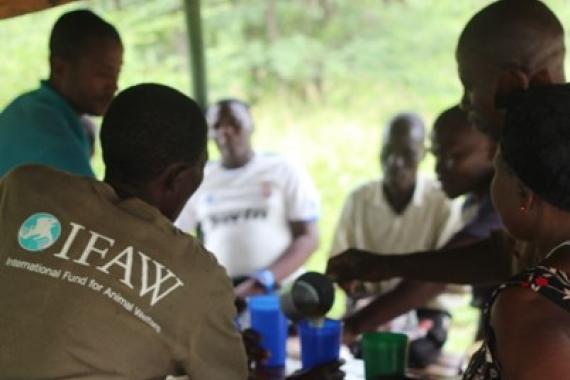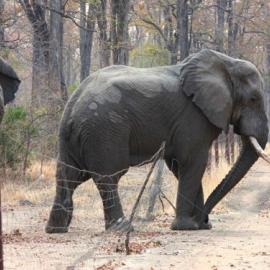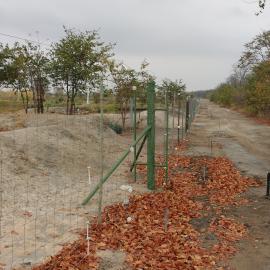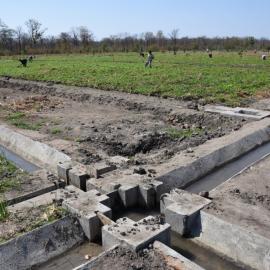The Chikolongo Livelihoods Project
Current initiative
Published

Community meeting at Chikolongo. Credit: Imani
People who live along the border of the Lilongwe National Park go into the park to poach fish and other animals, and to fetch water. As a result, people are often killed; sometimes by elephants but more often by crocodiles and hippos. Community residents know that many of their family and friends could easily die hunting for food and still, they go because they have no choice; they need the fish for protein and they need the water.
The Chikolongo Livelihoods project has successfully reduced poaching and human-wildlife conflict whilst benefitting local the local community, chiefly by improving food security and nutrition.
Lead

Location
The communities of Chikolongo live on the western boundary of Liwonde National Park, Malawi, where the initiative is taking place.
The poaching and wildlife trade problem
Species affected African Elephant Loxodonta africana , Hippos Hippopotamus amphibious , Nile Crocodile Crocodylus niloticus
Overview of the problem
HWC is the main issue, and mainly between people and elephants (‘Njovu’ in Nyanja/Chichewa), mainly because elephants leave the park; and crocodiles (‘Ngona’ in Chichewa) and hippopotamus (‘Mvuu’ in Chichewa) because people enter the park to get water.
Other key species at risk of poaching in Liwonde include:
- Black rhinoceros or hook-lipped rhinoceros (Diceros bicornis), ‘Chipembere’ (in Chichewa)
- Ground pangolin (Smutsia temminckii), also known as Temminck's pangolin or Cape pangolin, ‘Ngaka’ (in Chichewa)
- Leopard (Panthera pardus), ‘Kambuku’ (in Chichewa)
- Lion (Panthera leo), ‘Mkango’ (in Chichewa)
- African buffalo or Cape buffalo (Syncerus caffer), ‘Njati’ (in Chichewa)
In addition, a number of antelope species (common eland, sable antelope, waterbuck, bushbuck, impala, kudu) are poached for bushmeat.
The anti-IWT initiative
The primary objective of this project is to take a participatory and inclusive approach to “reduce human wildlife conflict (HWC) in the community whilst improving food security and nutrition.”
The HWC was mainly happening through: (1) people entering the park (mainly for access to water but also to poach, fish and take firewood) and (2) animals leaving the park and coming into contact with communities (e.g. elephants destroying crops).
This primary objective has been met through successful delivery of specific objectives, including:
2. providing access to water to the community outside the boundary fence, via a solar pump at the river (inside the park) and a pipeline which takes water under the fence;
4. improving the opportunities for livelihoods available to Chikolongo villagers through income generation, e.g. aquaculture, apiculture (honey), agriculture and aviculture (poultry).
The strategy
Strengthening disincentives for illegal behaviour
The 6 km community developed and established community fence is patrolled by people from the local community, who are paid.
Decreasing the costs of living with wildlife
Due to a combination of: (1) the community-developed boundary fence (6 km) to protect Chikolongo from animals coming onto their land and to alleviate instances of human-wildlife conflict; and (2) providing access to water to the community outside the boundary fence, via a solar pump at the river (inside the park) and a pipeline which carries the water under the fence, deaths from HWC now significantly reduced/eliminated. From an average of 3 deaths a month the community now experiences no deaths due to HWC incidences.
Increasing livelihoods that are not related to wildlife
There are two main strategies:
(1) improving food and nutritional security of the Chikolongo villagers (24 irrigated family plots, 5 fish ponds, irrigated food crop production); and
(2) improving the opportunities for livelihoods available to Chikolongo villagers through income generation, e.g. aquaculture, apiculture (honey), agriculture and aviculture (poultry).
Results:
• Food production from the farm has resulted in a 71% increase in protein consumption over the past three years, which should have a significant impact on health and nutrition.
• The irrigation system installed has increased crop rotations by an additional season - from 2 to 3 - and the community is now growing maize and rice, which significantly increases food security and improves resilience to adverse weather conditions (e.g. floods, droughts) that can lead to crop failure.
• Over 60 % of community reports gaining income from the sales of farm produce, some to local tourism lodges (e.g. Mvuu).
Improving education and awareness
Further detailThe project has provided a means for engaging with the wider community. Training on agriculture, irrigation, livestock management etc provides an opportunity to educate the community on the benefits of conservation management and sustainable use of natural resources.
Has the initiative made a difference?
All of the above have combined to reduce the residents’ of Chikolongo reliance on poaching animals and fish for protein and income.
As a result:
• The population of elephants has flourished, to the point of Liwonde now being in a position to be able to provide elephants to help restock other parks (e.g. Nkotakota).
• Deaths from HWC now significantly reduced/eliminated. From an average of 3 deaths a month the community now experiences no deaths due to HWC.
• The community's attitude towards wildlife has improved, from seeing wildlife as a threat, or a protein source, to seeing wildlife as beneficial, given the links established between wildlife and increased livelihood opportunities.
• Food production from the farm has resulted in a 71% increase in protein consumption over the past three years, which should have a significant impact on health and nutrition.
• The irrigation system installed has increased crop rotations from 2 to 3 and the community is now growing maize and rice, which significantly increases food security and improves resilience to adverse weather conditions (e.g. floods, droughts) that can lead to crop failure.
Organisers, donors and partners
This is a project is a partnership between the International Fund for Animal Welfare (IFAW), Imani Development Malawi (Imani) and the communities of Chikolongo, on the western boundary of Liwonde National Park, Malawi.
For further information contact Keith Bohannon (keithb@imanidevelopment.com).



